Measuring Carbon Tetrachloride Atmospheric Mixing Ratios in the Central Amazon Rainforest
The Column
Carbon tetrachloride (CCl4) is a potent greenhouse gas in the troposphere, while in the stratosphere it contributes to ozone destruction. Global atmospheric models treat anthropogenic industrial processes as the sole source of atmospheric CCl4. However, some evidence suggests that biogenic sources may also contribute. This article describes grab-sampling with analysis by thermal desorption–gas chromatography–mass spectrometry (TD–GC–MS) to assess levels of CCl4 in a Central Amazonian rainforest. We find that ambient air mixing ratios within and above the forest, while agreeing with current equatorial estimates (120 ppt), show diurnal and canopy-height variations that suggest a biogenic source of CCl4, and therefore may be important for closing the gaps in the global atmospheric CCl4 budget.
Photo Credit: Brasil2/Getty Images
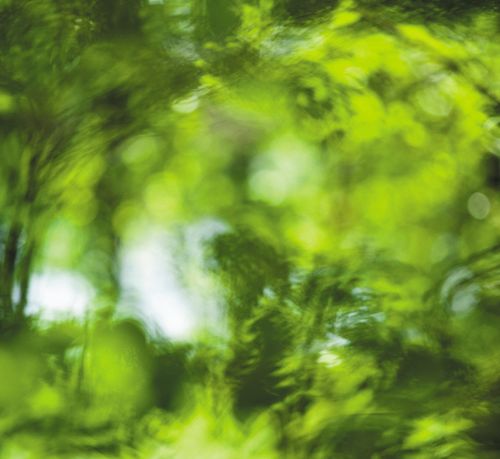
Angela Jardine1, David Barden2, and Kolby Jardine3, 1Climate and Environment Department, Instituto Nacional de Pesquisas da Amazônia, Manaus, Brazil, 2Markes International, Gwaun Elai Medi-Science Campus, Llantrisant, Wales, UK, 3Earth and Environmental Sciences Area, Climate and Ecosystem Sciences Division, Lawrence Berkeley National Laboratory, Berkeley, California, USA.
Carbon tetrachloride (CCl4) is a potent greenhouse gas in the troposphere, while in the stratosphere it contributes to ozone destruction. Global atmospheric models treat anthropogenic industrial processes as the sole source of atmospheric CCl4. However, some evidence suggests that biogenic sources may also contribute. This article describes grab-sampling with analysis by thermal desorption–gas chromatography–mass spectrometry (TD–GC–MS) to assess levels of CCl4 in a Central Amazonian rainforest. We find that ambient air mixing ratios within and above the forest, while agreeing with current equatorial estimates (120 ppt), show diurnal and canopy-height variations that suggest a biogenic source of CCl4, and therefore may be important for closing the gaps in the global atmospheric CCl4 budget.
Introduction
Climate Impacts of Atmospheric CCl4: In the troposphere, carbon tetrachloride (CCl4) is a greenhouse gas with a global warming potential 1400 times greater than CO2. With an estimated lifetime of 34 years, CCl4 is considered chemically inert in the troposphere. However, in the stratosphere, CCl4 photochemical reactions contribute to stratospheric ozone depletion and therefore CCl4 was marked as a compound to phase out of industrial processes by the 1987 Montreal Protocol (1).
Global CCl4 Atmospheric Budget: Satellite observations from space demonstrate that the greatest global CCl4 atmospheric mixing ratios (100–130 parts per trillion [ppt]) are found in the troposphere (<10 km altitude) over the mid-latitude industrialized regions and above the equatorial tropics (1). The primary CCl4 sink is stratospheric photochemical destruction while the oceans and soils are considered minor CCl4 sinks (but these remain poorly characterized).
It is currently assumed that anthropogenic industrial processes are the sole source of CCl4 to the atmosphere. However, the global atmospheric CCl4 budget suggests a missing CCl4 source (2), and there is some evidence supporting a potentially important biogenic CCl4 source. For example, plant enclosure studies in shrub land and coastal ecosystems in southern California (3), as well as creosote bush in the Sonoran Desert of Arizona (4), showed net emissions of CCl4. A recent study found that live and decaying plants, mosses, and microbes from a mid-latitude spruce forest can emit CCl4 (2). The authors concluded that biogenic surface emissions to the atmosphere may make only a minor source contribution on the global scale. However, CCl4 emissions have not been characterized in many ecosystems including tropical forests, which cycle more carbon and water than any other biome on Earth (5).
As a result of its high volatility, current methods for ambient CCl4 quantitation involve flask sample collections followed by cryogenic focusing and subsequent analysis by GC–MS (2). However, this greatly limits the ability to evaluate how atmospheric CCl4 levels vary vertically throughout a forest and temporally across a day; the automated collection of a large number of flask samples is not practical, both in terms of the high costs of multiflask sampling systems, their limited portability to remote field studies, and complicated experimental setups. Thus, the vertical and temporal patterns of CCl4 are not well-characterized in any ecosystem, including in the tropics.
In this study, we demonstrate the feasibility of characterizing vertical and diurnal patterns of ambient CCl4 for a primary rainforest ecosystem in the Central Amazon, using sampling of ambient air onto commercial thermal desorption tubes using either a manually-operated grab-sampler or by automated pumped sampling, followed by quantitation using thermal desorption–gas chromatography–mass spectrometry (TD–GC–MS). Eight mid-day vertical patterns of CCl4 mixing ratios were observed between November 2013 and July 2014. In addition, diurnal patterns (05:00–17:00) of CCl4 mixing ratios above the main forest canopy were assessed on eight days between June and September 2015.
Experimental
Field Site: Ambient air samples were collected at a central Amazon field site (Reserva Biologica da Cuieiras; also referred to as ZF2), which is approximately 60 km NNW of Manaus, Brazil (2° 35’ 48.09” S, 60° 13’ 11.43” W), and managed by the National Institute for Amazon Research (INPA). Samples were collected from the 50 m tall K34 eddy flux tower, situated on a plateau surrounded by primary rainforest. The forest structure surrounding the tower has an upper canopy top at 29 m with a subcanopy top at 17 m (6).
Vertical Gradient Sampling: Nineâpoint vertical gradients of CCl4 were collected at the K34 tower (heights of: 0 m, 13 m, 17 m, 21 m, 25 m, 29 m, 34 m, 38 m, and 50 m and one blank tube) by drawing 1.0 L of ambient air through a conditioned stainless steel thermal desorption tube packed with Tenax TA/Carbograph 1TD/Carboxen 1003 adsorbents and permanently fitted with internal diffusion-limiting inserts (SafeLok, Markes International) to eliminate accidental sample loss or contaminant ingress during sample transport, and so avoid sole reliance on caps for sample security. Each sample was collected within 4 min using a volumetrically calibrated manual grabâsampler (Easy-VOC, Markes International) and each 9-point vertical gradient was completed within 60 min. Eight vertical ambient air gradients were collected between 8 November 2013 and 17 July 2014 during rain-free afternoon periods (13:00–16:30 local time [LT]).
Diurnal Upper Canopy Sampling: Natural 12-h patterns (05:00–17:00 LT) of ambient air CCl4 concentrations above the canopy were quantified for a primary rainforest at 29 m height on the K34 tower in the Central Amazon. In total, eight collections were made from 24 June to 29 September 2015 using an automated volatile sampling system (Less P, Signature Science). Samples were automatically collected onto Quartz wool/Tenax TA/Carbograph 5TD thermal desorption tubes (Markes International) in 60-min intervals at a flow rate of 75 mL/min (24 June to 21 July 2015) or in 30-min intervals at a flow rate of 150 mL/min (18 August to 12 September 2015).
TD: Instrument: TD-100 (Markes International). Dry-purge: 10 min at 20 mL/min. Pre-purge: 1 min at 20 mL/min to split. Tube desorb: 10 min at 250 °C and 20 mL/min trap flow (no split). Focusing trap: TO-15/TO-17 Air Toxics (suitable for monitoring C2/3–C30/32). Pre-trap fire purge: 1 min at 20 mL/min. Trap low: 25 °C. Trap high: 300 °C.
GC: Column: 61.7 m × 320 µm, 1.8âµm J&W Rtx-624 10972-125 (Agilent Technologies) with 1.7 m integrated guard column. Carrier gas: Helium, 1.5 mL/min. Oven temp.: 35 °C for 3 min then 6 °C/min to 230 °C (hold 0 min). Total run time:
35.5 min.
Quadrupole MS: Data rate: 7.4 scans/s, Mass range: m/z 35–210. Acquisition mode: SCAN. EMV gain factor: 15. Resulting EM voltage: 1647 V. Ion source: 230 °C. Transfer line: 170 °C.
CCl4 calibration: The TD–GC–MS was calibrated to CCl4 using a 5-point calibration curve consisting of the following CCl4 mixing ratios (0.0, 1.2 ppb, 1.7 ppb, 2.3 ppb, and 2.9 ppb) prepared using the Dynamic Solution Injection technique (7). Two TD calibration samples at each mixing ratio were collected for 10 min at 100 mL/min. Calibration solutions were prepared by diluting 1.0 mL of 200 µg/mL CCl4 in methanol (SigmaâAldrich) with 9.0-mL methanol to produce a final liquid concentration of 20 µg/mL. Gas-phase CCl4 calibration ratios were prepared by injecting 0.0, 0.4 µL/min, 0.6 µL/min, 0.8 µL/min, and 1.0 µL/min of the calibration solution into 1.0 L/min of ultrahigh-purity hydrocarbonâfree air. TD–GC–MS calibration curves were generated by plotting the peak area of m/z 117 at retention time of 12.54 min against the total collected amount of CCl4 (nL). The calibration results showed high linearity and sensitivity for CCl4 quantitation by TD–GC–MS, and analysis of samples without CCl4 added (0.0 ppb) showed a negligible m/z 117 peak (Figure 1[a]). In addition, CCl4 peaks from TD samples collected from the Amazon forest showed excellent mass spectra and retention time agreement with the calibration standard (Figure 1[b]).
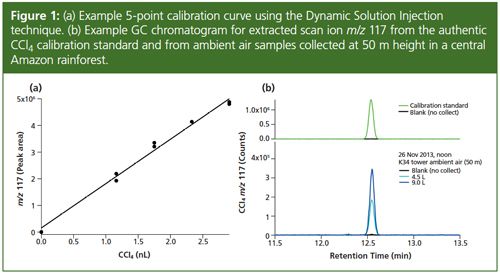
Software: MSD Chemstation software (Agilent) was used for instrument control. MassHunter Workstation Quantitative Analysis software for GC–MS (Agilent) was used for CCl4 quantitation of all samples. Sample statistical analysis and figure generation were completed with IGOR Pro software (Wave Metrics).
Results and Discussion
CCl4 Vertical Gradients with High Spatial Resolution: Eight 9-point vertical gradients of ambient air CCl4 mixing ratios were collected between 8 November 2013 and 17 July 2014 (see Figure 2), and although there was considerable variability between days, a consistent pattern emerged. A minimum was observed near the ground (17 ± 10 ppt), with ratios increasing with height to reach a maximum in the lower canopy at 21 m (54 ± 34 ppt) followed by a second maximum just above the upper canopy at 34 m (64 ± 26 ppt). Mixing ratios declined above the main canopy to what is assumed to be the well-mixed boundary layer, with a mixing ratio at 50 m of 29.8 ± 29.0 ppt.* As the minimum mixing ratios were observed near the ground, these observations are consistent with the assumption in global budgets that soils act as a net CCl4 sink. In addition, clear canopy enrichments in CCl4 mixing ratios, above both the ground and the tropospheric background, suggests potential biogenic CCl4 vegetation sources within the canopy and a net ecosystem source of CCl4 to the atmosphere.
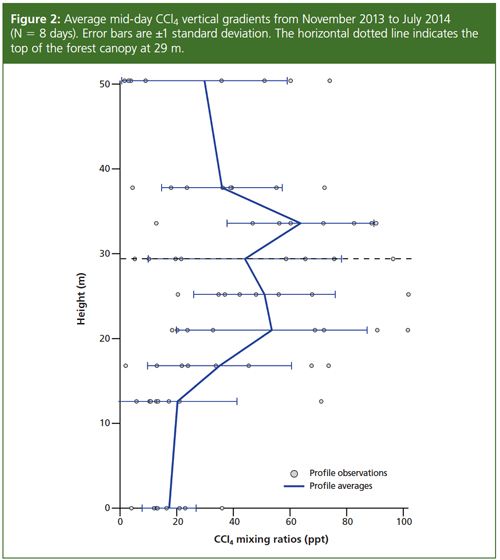
Ambient CCl4 Diurnal Mixing Ratios: Eight diurnal observations (05:00–17:00 LT) of CCl4 ambient air mixing ratios at the top of the canopy (29 m) were collected between 24 June and 12 September 2015 (see Figure 3). Diurnal curves showed a clear and strong decrease in CCl4 in the early morning to a minimum of 90 ± 19 ppt at 07:30 LT, followed by a recovery and gradual increase to a maximum of 100 ± 14 ppt at 12:30 LT. A slight decline started at 13:00 LT, and levels remained elevated but variable throughout the afternoon. Thus, the diurnal patterns of CCl4 mixing at the top of the main canopy show a similar diurnal pattern (with mid-day to early afternoon maxima) as observed for other biogenic volatile organic compounds emitted by tropical forests.
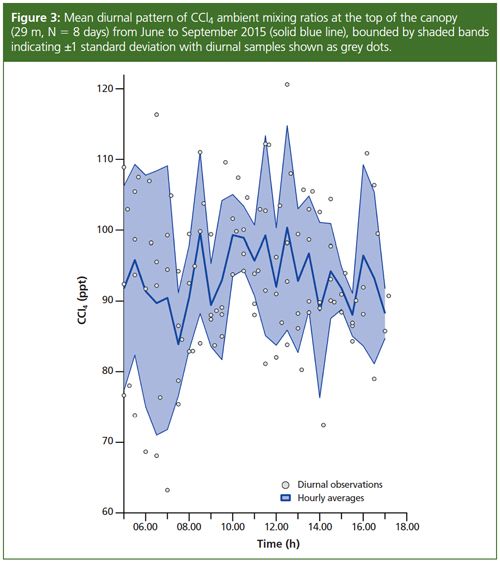
The sharp early-morning decrease in ambient air CCl4 indicates a physical response to the growing boundary layer where a dilution of within-canopy air by free troposphere air occurs. These results are not consistent with the view of tropical ecosystems as a net atmospheric sink. Instead, the build-up of mixing ratios throughout the day when temperatures are higher supports the alternative hypothesis tested here that tropical forests may be acting as a net biogenic source of CCl4 to the troposphere.
Conclusions
In this study, the feasibility to study biosphere–atmosphere exchange processes involving CCl4 using rapid and convenient sampling methods in conjunction with TD–GC–MS was demonstrated. While the vertical profiles in the Amazon are consistent with the view of soils as a net atmospheric CCl4 sink, a net ecosystem source to the atmosphere is suggested by observations of higher ambient CCl4 within the forest canopy than above it. This is supported by diurnal observations at the top of the main canopy, which show a small but significant diurnal enhancement in CCl4, with higher concentrations during the middle of the day than morning or early evening. Moreover, a significant decline in ambient CCl4 mixing ratios following the initiation of turbulent mixing in the morning was always observed, possibly as a result of mixing free CCl4âdepleted troposphere air into the forest. The results are not consistent with the view of the terrestrial biosphere as a net atmospheric sink of CCl4, and highlight the need for a more detailed gas-exchange survey in the tropics at multiple spatial and temporal scales using both soil and plant enclosures as well as ecosystem and landscape flux studies. These should be coupled with studies aimed at determining the biochemical pathways involved in plant and soil CCl4 metabolism. While additional observations are needed in tropical ecosystems to verify potential net biogenic sources of CCl4 as an important contributor to the missing global source(s), our observations are consistent with satellite observations revealing enhanced tropospheric CCl4 in the tropics (1).
Acknowledgements
This material is based upon work supported as part of the GoAmazon 2014/5 and the Next Generation Ecosystem ExperimentsâTropics (NGEE-Tropics) funded by the U.S. Department of Energy, Office of Science, Office of Biological and Environmental Research through contract No. DE-AC02-05CH11231 to LBNL, as part of DOE’s Terrestrial Ecosystem Science Programme. Additional funding for this research was provided by the Brazilian Conselho Nacional de Desenvolvimento Científico e Tecnológico (CNPq). We would like to thank the Forest Management (MF), Climate and Environment (CLIAMB), and Large Scale Biosphere-Atmosphere (LBA) programmes at the National Institute for Amazon Research (INPA) for logistical and infrastructure support during field measurements.
References
- N. Allen et al., Atmospheric Chemistry and Physics9, 7449–7459 (2009).
- S. Forczek, F. Laturnus, J. Doležalová, J. Holík, and Z. Wimmer, Plant Soil Environ. 61, 103–108 (2015).
- R.C. Rhew, B.R. Miller, and R.F. Weiss, Atmospheric Environment42, 7135–7140 (2008).
- K. Jardine et al., Atmospheric Chemistry and Physics10, 12191–12206 (2010).
- J. Chambers et al., Next Generation Ecosystem Experiment (NGEE) Tropics. (2014).
- A. Jardine et al., Geophysical Research Letters 42, 1576–1583 (2015).
- K. Jardine, W. Henderson, T. Huxman, and L. Abrell, Atmospheric Measurement Techniques3, 1569–1576 (2010).
*Mixing ratios above the canopy in this part of our study were lower than those expected from satellite observations (100–130 ppt) (1), and our subsequent work indicated that the choice of sorbents used in the TD tubes may have been a factor in this. In particular, the study of diurnal mixing ratios described in this paper, which used a different sorbent combination (see Experimental), gave results in better agreement with satellite observations. We have reason to believe that the same sorbent combination may also give a more representative indication of CCl4 levels in the specific case of grab-sampling relatively large (1 L) volumes using a volumetrically calibrated manual grab-sampler.
Angela Jardine received her Ph.D. in May 2016 from the Climate and Environment Program at the National Institute for Amazon Research in Manaus, Brazil. She obtained her B.S. in mechanical engineering from the Colorado School of Mines in Golden, Colorado, USA, and her M.S. in hydrology from the University of Arizona in Tucson, Arizona, USA. She was the associate editor of the Assessment of Climate Change in the Southwest report for the United States 2013 National Climate Assessment Report (Island Press).
David Barden is technical copywriter at Markes International, having joined the company in 2011. David studied natural sciences at the University of Cambridge, UK, and remained there for his Ph.D. in organic chemistry, which he received in 2003. A placement at the European Journals Department of Wiley-VCH, Weinheim, Germany, was then followed by seven years in journal publishing at the Royal Society of Chemistry, UK.
Kolby Jardine is a research scientist studying ecosystem metabolomics through volatile trace gas exchange between the biosphere and atmosphere at the Earth and Environmental Sciences Area at Lawrence Berkeley National Laboratory in Berkeley, California, USA, since 2012. He received his B.S. in biochemistry from New York University, USA, his M.S. in biosphere-atmosphere interactions from South Dakota School of Mines, in Rapid City, South Dakota, USA, and his Ph.D. in marine and atmospheric sciences from Stony Brook University in Stony Brook, New York.
E-mail: enquiries@markes.com
Website:www.markes.com
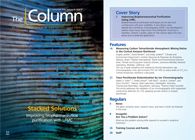
Determining Enhanced Sensitivity to Odors due to Anxiety-Associated Chemosignals with GC
May 8th 2025Based on their hypothesis that smelling anxiety chemosignals can, like visual anxiety induction, lead to an increase in odor sensitivity, a joint study between the University of Erlangen-Nuremberg (Erlangen, Germany) and the Fraunhofer Institute for Process Engineering and Packaging (Freising, Germany) combined behavioral experiments, odor profile analysis by a trained panel, and instrumental analysis of odorants (gas chromatography-olfactometry) and volatiles (gas chromatography-mass spectrometry).
Investigating 3D-Printable Stationary Phases in Liquid Chromatography
May 7th 20253D printing technology has potential in chromatography, but a major challenge is developing materials with both high porosity and robust mechanical properties. Recently, scientists compared the separation performances of eight different 3D printable stationary phases.
Detecting Hyper-Fast Chromatographic Peaks Using Ion Mobility Spectrometry
May 6th 2025Ion mobility spectrometers can detect trace compounds quickly, though they can face various issues with detecting certain peaks. University of Hannover scientists created a new system for resolving hyper-fast gas chromatography (GC) peaks.

.png&w=3840&q=75)

.png&w=3840&q=75)



.png&w=3840&q=75)



.png&w=3840&q=75)








